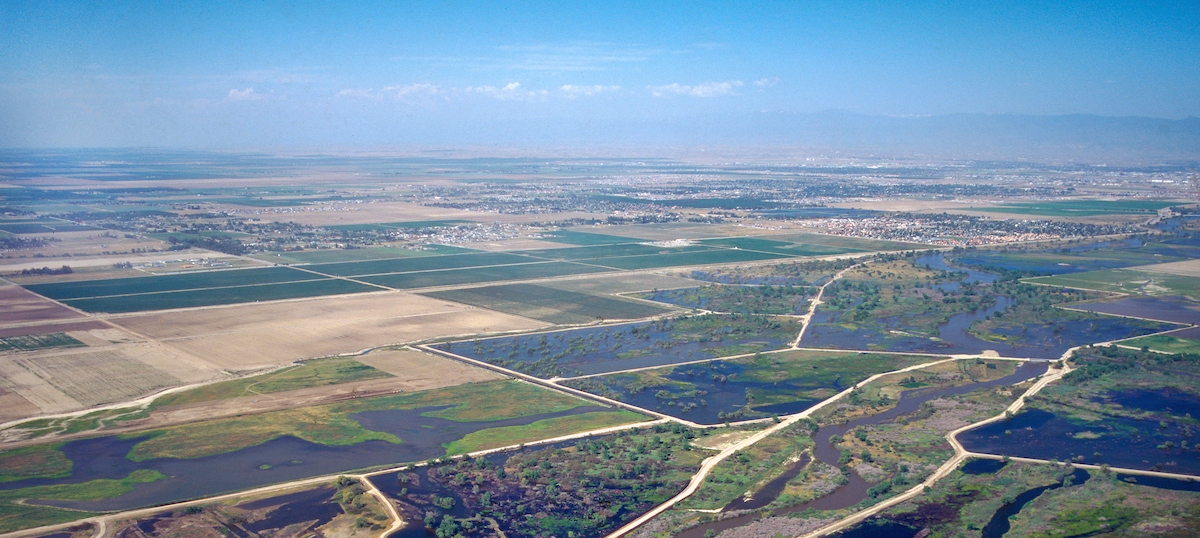Sustainable Groundwater Management Act (SGMA)

SGMA:
The Sustainable Groundwater Management Act (SGMA) was signed into law in September of 2014. SGMA is a product of three bills, Assembly Bill 1739 (Roger Dickinson, D-Sacramento) and Senate Bills 1168 and 1319, both by (Senator Fran Pavley, D-Agoura Hills), providing a broad new regulatory framework to manage groundwater. Farm Bureau’s primary focus during the legislative process was on maintaining local control which is consistent with Farm Bureau policy (No. 75). Although local management is consistent with our policy, Farm Bureau and other agricultural organizations actively worked to resolve a number of issues in the act.
Key amendments Farm Bureau was able to help secure include:
- Language aimed at protecting existing groundwater rights,
- Raising and deferring thresholds for potential triggers on surface connections to groundwater,
- Increasing timelines to assist local entities with compliance,
- Decoupling the actions of entities in compliance from the actions of noncompliant agencies,
- Deferring and relaxing requirements for basins not yet in overdraft, and
- Removing language that would have authorized the California Department of Fish and Wildlife to prioritize basins based on connectivity to groundwater-dependent ecosystems.
Notwithstanding the amendments we secured, we still had many concerns with the three-bill package and that is why Farm Bureau asked the Governor to veto the measures at the time.
-
- Farm Bureau has since developed two SGMA brochures and six inserts that can be accessed here:
- SGMA Brochure
- SGMA Hydrology Brochure
- SGMA Lowering Groundwater Levels
- SGMA Decrease in Groundwater Storage
- SGMA Seawater Intrusion
- SGMA Water Quality
- SGMA Land Subsidence
- SGMA Surface Water Depletion
- The Department of Water Resources implements SGMA. Additional information is available on the department’s Sustainable Groundwater Management Program website at: https://water.ca.gov/Programs/Groundwater-Management/SGMA-Groundwater-Management
Multi Benefit Land Repurposing (MBLR):
An Environmental Defense Fund (EDF) sponsored measure that would require the Department of Conservation to establish and administer a program named the “Multi-benefit Land Repurposing Incentive Program” to provide grants to groundwater sustainability agencies (GSAs), counties, or others was introduced in the 2020 Legislative Session (AB 2642 by Rudy Salas, D-Bakersfield) and again in 2021 (AB 252 by Robert Rivas, D-Hollister). Farm Bureau worked with EDF on both measures to address concerns and amend the bills to benefit landowners impacted by the Sustainable Groundwater Management Act (SGMA). Both measures failed, so the Farm Bureau worked with the California Department of Food and Agriculture to help establish the program with an initial $500 million general fund allocation in the 2021-22 budget to assist voluntary landowners, farmers and ranchers that have lost their ability to irrigated due to SGMA.
-
- Department of Conservation MBLR Program information can be accessed here: https://www.conservation.ca.gov/dlrp/grant-programs/Pages/Multibenefit-Land-Repurposing-Program.aspx
- You may contact the Department with questions or for technical assistance with your application.
Bay-Delta Plan Update (Unimpaired Flows):
State and federal water quality laws—the federal Clean Water Act and California’s Porter-Cologne Act—require the State Water Resources Control Board to conduct period updates of the Sacramento-San Joaquin River Bay-Delta Water Quality Control Plan (Bay-Delta Plan). Plan updates currently in progress seek to review and potentially amend Bay-Delta standards last updated in 2006. The purpose is to review and update existing water quality standards in the Bay-Delta and its extended watershed to afford reasonable protection for designated beneficial uses, including both municipal and industry, agricultural, domestic, environmental water quality standards. Delta salt intrusion control updates and instream flows for salmon are notable features of the current update. Additional information can be found on the Board’s website
here.
-
- Phase I – The Board adopted updated Southern Delta salinity standards and instream flow standards for fish in 2018. The Board’s 2018 amendments relaxed the Bay-Delta Plan’s prior Southern Delta salinity standards. On the Lower San Joaquin, the Stanislaus, the Tuolumne, and the Merced, the Board’s amendments set instream fish flow standards equivalent to 30 and 50 percent of runoff in each watershed, from February through June, with proposed year-round flow shifting of this total volume of water and on-going ‘adaptive management,’ starting at 40 percent. This represents a large increase over historic flows and would have dramatic economic and water supply consequences for the affected region, especially in drier years. Actual implementation of these new standards is a separate step and must take account of the impact on affected water rights priorities. Pending litigation by several parties, including the California Farm Bureau, challenges the substitute environmental document underlying the Board’s Phase 1 update. Addition information on Phase 1 can be found
here. - Phase II – The second phase of the Board’s current Bay-Delta update applies to the Sacramento River and its tributaries and the remainder of the Delta. The Board’s current proposal for this phase would seek between 45 and 65 percent of all spring runoff in the Sacramento River watershed, starting at 55 percent. As with the Board’s Phase 1 standards, this amounts to an enormous volume of water above existing flows and would have devastating consequences for the Sacramento River region and, indeed, for the rest of the state. The Board has yet to prepare any environmental document for this phase, and has not yet proposed any actual, corresponding amendments to the Plan itself. As with Phase I, actual implementation of updates standards would require assignment of responsibility, including consideration of existing water rights. Additional information on Phase II can be found
here. - Voluntary Agreements – Proposed Bay-Delta voluntary agreements would substitute at voluntary contributions of land, water, and funding over scientific research and other activities water users in various parts of the extended Bay-Delta watershed in lieu of formal, regulatory implementation of the Board’s Phase 1 and Phase 2 standards. Negotiations to define details of these voluntary agreements have been underway for several years. Information regarding the voluntary agreements can be found
here.
- Phase I – The Board adopted updated Southern Delta salinity standards and instream flow standards for fish in 2018. The Board’s 2018 amendments relaxed the Bay-Delta Plan’s prior Southern Delta salinity standards. On the Lower San Joaquin, the Stanislaus, the Tuolumne, and the Merced, the Board’s amendments set instream fish flow standards equivalent to 30 and 50 percent of runoff in each watershed, from February through June, with proposed year-round flow shifting of this total volume of water and on-going ‘adaptive management,’ starting at 40 percent. This represents a large increase over historic flows and would have dramatic economic and water supply consequences for the affected region, especially in drier years. Actual implementation of these new standards is a separate step and must take account of the impact on affected water rights priorities. Pending litigation by several parties, including the California Farm Bureau, challenges the substitute environmental document underlying the Board’s Phase 1 update. Addition information on Phase 1 can be found
Department of Water Resources:
The Department of Water Resources (DWR) is within the California Natural Resources Agency. The department’s charged with protecting, conserving, developing, and managing California's water supply. This includes the State Water Project (SWP), supplying water to nearly 27 million Californians and 750,000 acres of farmland. It spans from Northern California to Southern California and includes 36 storage facilities, 21 pumping plants, 26 dams, 5 hydroelectric power plants, 4 pumping-generating plants, and approximately 700 miles of canals, tunnels, and pipelines. The SWP also provides flood control, hydroelectric power generation, recreational opportunities, and ecosystem enhancements to protect fish and wildlife habitat.
DWR's responsibilities include:
- Overseeing the statewide process of developing and updating the California Water Plan (Bulletin 160);
- Overseeing the statewide process of developing and updating California’s Groundwater – Update 2020 (Bulletin-118), and a companion web-based application called California’s Groundwater Live (CalGW Live);
- Planning, designing, constructing, operating, and maintaining the SWP;
- Protecting and restoring the Sacramento-San Joaquin Delta;
- Regulating dams, providing flood protection, and assisting in emergency management;
- Working to preserve the natural environment and wildlife;
- Educating the public about the importance of water, water conservation, and water safety;
- Providing grants and technical assistance to service local water needs; and
- Collecting, analyzing, and reporting data to manage and protect California’s water resources.
- State Water Project Water Allocations: https://water.ca.gov/News/News-Releases/2021/Dec-21/SWP-December-Allocation
U.S. Bureau of Reclamation:
The Bureau of Reclamation’s mission is to manage, develop, and protect water and related resources.
Established in 1902, the Bureau of Reclamation has constructed dams, powerplants, and canals in the 17 western states. These water projects led to homesteading and promoted the economic development of the West. Reclamation has constructed more than 600 dams and reservoirs, among those is Shasta Dam, built between 1938 and 1945. Originally a state project picked up by the federal government during the great depression. The head of the federal Central Valley Project (CVP), Shasta holds 4.55 million acre feet of water and is 602 feet high. The CVP has 22 lakes/reservoirs, 11 million acre feet total storage, 500 miles canals/pipelines and provides water to 3 million acres of farmland.
-
- Central Valley Project Information: https://www.usbr.gov/mp/cvo/
- Central Valley Project Water Allocations: https://www.usbr.gov/mp/cvp-water/allocations.html
- Central Valley Flood Protection Plan 2022: https://water.ca.gov/News/News-Releases/2022/April-22/Central-Valley-Flood-Protection-Plan-Update-Released




.svg.png?cacheid=0.9616018850896426)